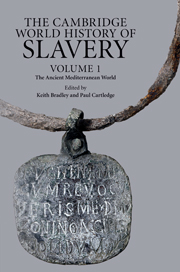Book contents
- Frontmatter
- Contents
- Series editors' introduction
- List of figures
- Acknowledgements
- Introduction
- 1 Slavery in the ancient Near East
- 2 Slaves in Greek literary culture
- 3 Classical Athens
- 4 The Helots: a contemporary review
- 5 Slavery and economy in the Greek world
- 6 The slave supply in classical Greece
- 7 Slavery and the Greek family
- 8 Resistance among chattel slaves in the classical Greek world
- 9 Archaeology and Greek slavery
- 10 Slavery in the Hellenistic world
- 11 Slavery and Roman literary culture
- 12 Slavery in the Roman Republic
- 13 Slavery Under the Principate
- 14 The Roman slave supply
- 15 Slave labour and Roman society
- 16 Slavery and the Roman family
- 17 Resisting slavery at Rome
- 18 Slavery and Roman material culture
- 19 Slavery and Roman law
- 20 Slavery and the Jews
- 21 Slavery and the rise of Christianity
- 22 Slavery in the late Roman world
- Bibliography
- General index
- Index of ancient passages cited
- Index of inscriptions and papyri
- Index of Jewish and Christian Literature Cited
18 - Slavery and Roman material culture
Published online by Cambridge University Press: 28 September 2011
- Frontmatter
- Contents
- Series editors' introduction
- List of figures
- Acknowledgements
- Introduction
- 1 Slavery in the ancient Near East
- 2 Slaves in Greek literary culture
- 3 Classical Athens
- 4 The Helots: a contemporary review
- 5 Slavery and economy in the Greek world
- 6 The slave supply in classical Greece
- 7 Slavery and the Greek family
- 8 Resistance among chattel slaves in the classical Greek world
- 9 Archaeology and Greek slavery
- 10 Slavery in the Hellenistic world
- 11 Slavery and Roman literary culture
- 12 Slavery in the Roman Republic
- 13 Slavery Under the Principate
- 14 The Roman slave supply
- 15 Slave labour and Roman society
- 16 Slavery and the Roman family
- 17 Resisting slavery at Rome
- 18 Slavery and Roman material culture
- 19 Slavery and Roman law
- 20 Slavery and the Jews
- 21 Slavery and the rise of Christianity
- 22 Slavery in the late Roman world
- Bibliography
- General index
- Index of ancient passages cited
- Index of inscriptions and papyri
- Index of Jewish and Christian Literature Cited
Summary
INTRODUCTION
At its best, Roman material culture brings a dimension to historical inquiry that written sources cannot by recapturing the texture of daily life and by providing a unique angle from which to interpret cultural attitudes and behaviour. This is especially important for Roman slavery since there are no slave narratives or plantation account books as there are from the antebellum American South, nor the vivid descriptions by contemporary commentators of slave systems'in Brazil or the Caribbean. In Roman archaeology, where the framework provided by historical texts has always prevailed over theory, the absence of written documentation makes the task of seeing slaves in the archaeological record particularly challenging. Furthermore, the value of material culture is defined by both the quality of its preservation and the nature of the analysis that is brought to bear by scholars. Both factors have had critical consequences for the contribution material culture has made to the study of Roman slavery. At first glance, when compared to other aspects of Roman society and to the ubiquity and economic importance of slaves, Roman material culture offers relatively scant direct evidence. Much of this is due to the poor quality of housing, clothing and other goods used by slaves that reduces their chances of survival in the archaeological record and makes it impossible to reconstruct, for example, slave religion, diet, or other aspects of a slave subculture.
- Type
- Chapter
- Information
- The Cambridge World History of Slavery , pp. 385 - 413Publisher: Cambridge University PressPrint publication year: 2011
- 13
- Cited by

